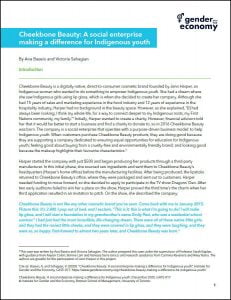Overview
This case study details how Jenn Harper founded Cheekbone Beauty, a direct-to-consumer cosmetic brand, with the purpose-driven business model of supporting and empowering Indigenous youth. Cheekbone Beauty further aims to change the consumer-focused narrative in cosmetics by embracing and championing the circular economy, where their products are sustainable from harvest to end of life.
Course Topics:
- Entrepreneurship
- Business design
- Indigenous entrepreneurship
- Innovation
- Social enterprise/entrepreneurship
- Sustainability
Introduction:
Cheekbone Beauty is a digitally native, direct-to-consumer cosmetic brand founded by Jenn Harper, an Indigenous woman who wanted to do something to empower Indigenous youth. She had a dream where she saw Indigenous girls using lip gloss, which is when she decided to create her company. Although she had 15 years of sales and marketing experience in the food industry and 12 years of experience in the hospitality industry, Harper had no background in the beauty space. However, as she explained, “[I] had always been looking, I think my whole life, for a way to connect deeper to my Indigenous roots, my First Nations community, my family.” Initially, Harper wanted to create a charity. However, financial advisors told her that it would be better to start a business and find a charity to donate to, so in 2016 Cheekbone Beauty was born. The company is a social enterprise that operates with a purpose-driven business model: to help Indigenous youth. When customers purchase Cheekbone Beauty products, they are doing good because they are supporting a company dedicated to ensuring equal opportunities for education for Indigenous youth; feeling good about buying from a cruelty-free and environmentally friendly brand; and looking good because the makeup highlights their favourite characteristics.

View and download the full case study.
__________________________
This case was written by:
This case was written by Ana Baseio and Victoria Sahagian. The authors prepared this case under the supervision of Professor Sarah Kaplan, with guidance from Alyson Colón, Bonnie Lam and Vanessa Serra Iarocci and research assistance from Carmina Ravanera and Riley Yesno. The authors are grateful for the participation of Jenn Harper in this project.







